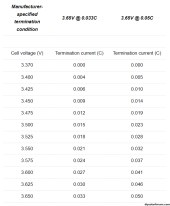Alarchist
New Member
I often see quoted the standard LFP 0.033C or 0.05C Cell datasheet rate as termination current for fully charged cells.
For EVE 280K: 280A x 0.05 = 14A (@3.65v)
For Gotion 340: 340 x 0.05 = 17A (@3.65v)
Etc.. (I have the Gotion)
This is always specified by Cell manufacturers when charging to 3.65v per cell. However it gets regularly repeated here when charging to only 3.45v per cell.
There was a long rambling thread recently which touched on it: Almost everyone is charging their LFP wrong! - post 69
With references from: https://nordkyndesign.com/charging-marine-lithium-battery-banks/
The critical point being that according to Nordkyn Design, we should be adjusting termination current based on termination voltage, not use a set figure for all termination voltages.
Table from the Nordkyn Site:

According to the above, if using 3.45v termination voltage we should actually terminate at 0.014C
For EVE 280K: 280A x 0.014 = 3.92A (@3.45v)
For Gotion 340: 340 x 0.014 = 4.76A (@3.45v)
Ok so maybe we want to be careful not to overcharge, and the above table is the cut-off rate that we MUST stop at, but it's also maybe a useful ready reckoner to help know where the tail current cut off absolute point is.
Or is it safer just to ignore it for the minimal extra Ah pushed in and stick to the 3.65v rating?
For EVE 280K: 280A x 0.05 = 14A (@3.65v)
For Gotion 340: 340 x 0.05 = 17A (@3.65v)
Etc.. (I have the Gotion)
This is always specified by Cell manufacturers when charging to 3.65v per cell. However it gets regularly repeated here when charging to only 3.45v per cell.
There was a long rambling thread recently which touched on it: Almost everyone is charging their LFP wrong! - post 69
With references from: https://nordkyndesign.com/charging-marine-lithium-battery-banks/
The critical point being that according to Nordkyn Design, we should be adjusting termination current based on termination voltage, not use a set figure for all termination voltages.
Table from the Nordkyn Site:

According to the above, if using 3.45v termination voltage we should actually terminate at 0.014C
For EVE 280K: 280A x 0.014 = 3.92A (@3.45v)
For Gotion 340: 340 x 0.014 = 4.76A (@3.45v)
Ok so maybe we want to be careful not to overcharge, and the above table is the cut-off rate that we MUST stop at, but it's also maybe a useful ready reckoner to help know where the tail current cut off absolute point is.
Or is it safer just to ignore it for the minimal extra Ah pushed in and stick to the 3.65v rating?



